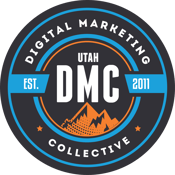This month’s DMC event featured Elli Bishop and Bill Slawski, two digital marketers with impressive backgrounds of success. At April’s DMC event, Elli shared her insights into what makes a great outreach specialist and how to hire one, and Bill covers phrase-based indexing and how Google patents can provide greater insights into the Google search algorithm.
Outreach From Scratch: How to Hire the Right People to Earn the Coverage You Need Why do I say this?
Elli Bishop has been handling B2B and B2C digital marketing for the past 8 years and knows what it takes to take a strategic approach to content creation. She’s a master at outreach and has worked to build up Clearlink’s outreach team which now has over 20 amazing marketers. Elli’s experience with content and outreach has helped her understand exactly what it takes to have a successful outreach campaign, and how you can find the best people and process for outreach as well.

Here are a few of her main takeaways:
- Help companies hire the right people for their outreach projects.
- Provide basic guidelines to follow when deciding who to hire for outreach positions.
- Determine which tactics to use for outreach to get the best results.
How to Hire the Right People to Earn the Coverage You Need
While outreach is often a last thought in the content creation process, Elli emphasizes that it is
your brand’s digital footprint and that you should remember to “sprinkle it throughout your
customer's digital experience.”
A great example of a successful marketing outreach campaign was an article done for Cabletv.com. The title of the article was “The Marvel Movie Marathon Dream Job” in which the company offered to pay someone $1,000 to binge watch all 20 of the Marvel movies. The article garnered a lot of attention and some really amazing backlinks from companies like CNBC, Forbes, Thrillist, and many, many more.
While doing outreach can mean different things to different people, Elli defines outreach as the process of creating and promotion industry-leading content to journalists, industry leaders, bloggers, influencers, and more to get links and traffic for your brand and website. Some people refer to outreach as off-site SEO, digital PR, or media relations.
Recruiting and Hiring
Finding great outreach specialists isn’t easy. In Elli’s case study, out of 325 applicants, only 40 qualified for an interview, and only one of those individuals had outreach experience. Elli believes that to find the best people for outreach you need to know what the perfect outreach specialist looks like. Here are her non-negotiables:
- Resilient
- Confident
- Persistent
- Competitive
- Persuasive Writer
- Great Researcher
- Creative Problem Solver
- Relationship-Builder
Elli believes the best people fresh out of college are the ones with degrees in English, Business, Marketing, or Rhetoric and Communications. Those with work experience are people who’ve worked as an editor, reporter, journalist, or freelance writers.
Testing Candidates
Besides finding individuals with the right background, you should also make sure you have a few filters to weed out candidates and ensure they are the right fit for an outreach position.
- Test #1: Test email. Give the candidate a test email and ask them to include a specific (and perhaps funny) word in the subject line. This tests the candidate’s attention to detail.
- Test #2: Screening questions. Asking what their favorite internet content is give you insight into whether they can spot good writing.
- Test #3: Test their knowledge of SEO. If they don’t know SEO, ask them what their top 5 ranking factors would be if they were a search engine. If they do have a background ask what Google’s top 5 ranking factors are.
Elli also likes to give her prospective hires a challenge to find the contact information for hard to reach individuals. She does this not only to see if they can respond well to a challenge, but to see how they approach the search as well. This test helps her answer the following:
- How well can they connect things?
- How well do they connect unrelated concepts they can use in their outreach approach?
- Are they fast at navigating the internet and using a computer?
- Finally, how well do they respond to pressure?
Primary Outreach Tactics
Elli knows what works and what doesn’t when it comes to outreach. Through her experience she’s identified three primary outreach tactics that are the most effective.
- Content Creation and Promotion: This needs to be data-driven content and pitches must be on-point.
- HARO: Stands for “Help a Reporter Out.” This outreach tactic is Elli’s recommendation for those who are short on time but need a good return. If outreach isn’t your primary responsibility or you’re short on time—do this first.
- Make Your Outreachers Freelance Journalists: Essentially, your in-house people need to be as avid and persistent as journalists. Daily pitching and persistence is key here. Can they keep going, even in the face of continuous rejection?
Elli’s message can be summed up by reiterating the importance of outreach. Outreach isn’t a part-time position and shouldn’t be an afterthought once all your other tasks have been accomplished. Instead, it should be a primary focus and we should find individuals who have the talent to do it well.
Bill Slawski
Bill Slawski has been in the SEO game since 1996 and is currently the Director of SEO Research for Go Fish Digital. His experience and expertise are shared in his blog “SEO by the Sea.” Bill draws his information from search engines themselves to get the most insights into how they work. Through his extensive research around search engine patents and phrase- based indexing, he’s found that these are a great way to see the development of search engines and how they function.
Here are a few of his main takeaways:
- Search engines look for meaningful phrases and avoid the ones that are not meaningful
- Neural matching affects the way in which language is used in a search engine
- Search engines work through semantic topic modeling, phrase-based indexing, and TFIDF.
How Search Algorithms Work
Bill's brief overview on the inner workings of search algorithms was highly insightful and included some excellent resources for those looking to expand their knowledge of search engine functions. His main focus, however, was on three main ways search algorithms work. Understanding more about the inner workings of search, help us better apply SEO principles.
1. Semantic Topic Modeling
Search engines use semantic topic modeling to determine which words are related to what an individual is searching for. It uses terms that are meaningful and adds to them with other related keywords. Finding related words based on the topics individuals search for helps refine the process of search by omitting irrelevant words. For example, someone searching for the keyword “tea,” may end up with search terms such as Lipton, lemon, berry, caffeine, cup, green, etc.
For a deeper dive into semantic topic modeling, Bill suggests checking out the article: “Improving semantic topic clustering for search queries with word co-occurrence and bigraph co-clustering.”
Original search engines worked similarly and used phrase-based search in an information retrieval system. Today, they collect possible phrases that can be used to find information on the web and avoid phrases that don’t have meaning in search. For example:
- Possible (Incomplete) Phrase: President of the...
- Not Meaningful: Top of the morning.
3. TF*IDF
Finally, understanding the basics of TF*IDF is a basic requirement for understanding how Google search works. TF stands for “term frequency,” and IDF stands for “inverse document frequency. When individuals type a query into Google’s search engine, this retrieval technique determines the TF and IDF score of any given word.
Higher TF*IDF scores indicate less common terms, while lower scores indicate more common terms. A broader, more common term might be the term “coke.” When an individual searches for “coke,” search engines must make some general assumptions about what the individual is searching for based on term volume. Are they looking for cocaine? Coca-Cola? A county in Texas? Or petroleum coke?
Key Insights
Understanding these three main aspects of search provides greater insights into how we can improve our SEO strategies and tactics. Bill provides many more resources and information on his blog at seobythesea.com that are worth a read for those looking to improve their working knowledge of search engine algorithms.

